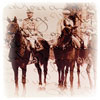Private Ralph Clement Gale was born in Youngs Cove, New Brunswick, on June 19, 1895, to parents George Hamilton and Alma Kate Gale. Prior to enlistment Ralph Gale worked as a school teacher.
Having previously served in the 28th Dragoons Militia, Gale enlisted for overseas service at Amherst, Nova Scotia, with the 6th Canadian Mounted Rifles on April 21, 1915. He sailed from Canada in July of 1915 and after training in England arrived in France in October of 1915, where he transferred to the 4th Battalion Canadian Mounted Rifles in early January of 1916.
He was captured during the Battle of Mount Sorrel near Ypres, Belgium, on June 2, 1916, and was held as a Prisoner of War in Germany at the Friedrichsfeld Camp in 1916/1917, and the Munster II (Rennbahn) Camp in 1918. Just a few months prior to the Armistice he died in a P.O.W. hospital (most likely of influenza), in Dortmund, Germany, on July 29, 1918. He was buried in the Cologne Southern Cemetery, Germany.
The earliest letters in the Gale Collection were written by Ralph Gale to his mother and his sisters prior to his capture in 1916. Once he became a P.O.W. he continued to write from the prison camps in Germany. Also included is correspondence between various family members and from organizations such as the Canadian Red Cross Society, and two photos of Ralph taken while held at Friedrichsfeld. There are several letters written by Canadian soldiers who were interred with Ralph at the Friedrichsfeld and/or Munster II (Rennbahn) Camps, and who wrote to his family following his death. Links to their Service Records have been included below. (Among them is George Williams who is also connected to the collection of fellow Rennbahn P.O.W. William McLeish through their work together in camp theatrical productions.)
Ralph’s brother Captain John Roberts Gale was also in service overseas in World War One, including serving with 5th Canadian Trench Mortar Battery, 2nd Canadian. Division, France. As most of the correspondence to or from John Gale relates directly to his brother’s internment as a P.O.W., all of his letters have been included as part of the Ralph Gale Collection, although they can also be viewed separately in the Capt. John Roberts Gale Collection.
The letters from the Canadian Red Cross to the Gale family were through the work of Evelyn Rivers Bulkeley who as Head of the Prisoner of War Branch managed all requests for aid regarding Canadian P.O.W.’s throughout the period of Robert Gale’s internment.
External links:
Pte. Ralph Gale’s service record (Serv/Reg# 111184) can be viewed/downloaded in pdf format through Library and Archives Canada.
Burial information is available at the Commonwealth War Graves Commission.
A memorial page honouring Pte. Ralph Gale can be visited online at the Canadian Virtual War Memorial.
Service Records of the other P.O.W.'s with letters in the Ralph Gale collection, at Library and Archives Canada:
Gunner George Henry Flewelling, 1st Canadian Divisional Ammunition Column, service record, (Serv/Reg# 43719)
Private Arnold Garfield Griffin, 4th Canadian Mounted Rifles, service record (Serv/Reg# 111209)
Private John Paine Aitchison Hayes, 9th Canadian Mounted Rifles, service record (Serv/Reg# 114326)
Private George Buford Williams, 7th Battalion, service record (Serv/Reg# 16487)




